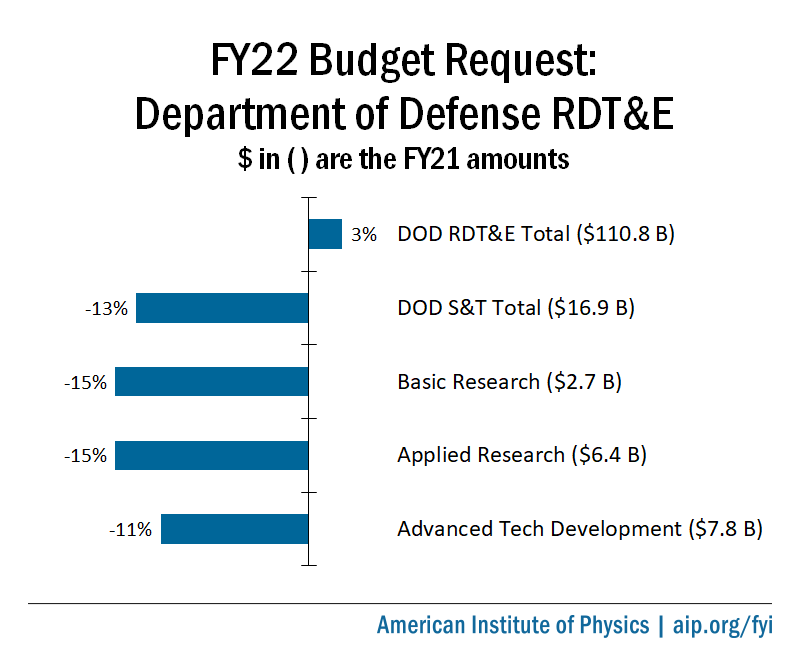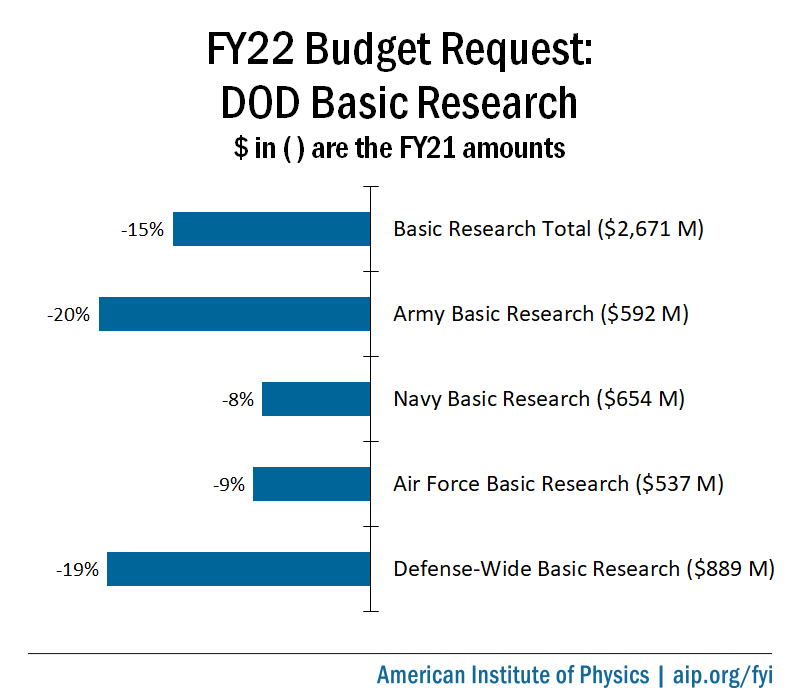
FY22 Budget Request: Department of Defense
The Biden administration is proposing
The portfolio comprises accounts funding basic research, applied research, and advanced technology development, which would each see double digit percentage cuts. Asked about the cuts during a hearing
Among its later-stage RDT&E programs, DOD continues to prioritize efforts focused on what it calls “advanced capability enhancers,”
Selected figures from the request are available in FYI’s Federal Science Budget Tracker


Basic research and STEM education
Total funding for basic research would fall 15% to $2.28 billion under the request, with cuts distributed across the military service branches and defense agencies.
University Research Initiatives. Across the Army, Navy, and Air Force, funding for University Research Initiatives would drop 21% to $347 million. These accounts fund the Multidisciplinary University Research Initiatives (MURI) program, the Defense University Research Instrumentation Program (DURIP), and the National Defense Science and Engineering Graduate Fellowships, among other activities.
Defense Research Sciences. Funding for Defense Research Sciences across the three service branches and the Defense Advanced Research Projects Agency would drop 9% to $1.51 billion. These accounts support a variety of intramural and extramural basic research projects.
DARPA. Funding for the Defense Research Sciences account at DARPA would drop 17% to $396 million, reversing a large increase Congress provided last year. DOD does however propose to increase DARPA’s basic medical research program by 41% to $76 million and to keep the agency’s overall budget
Social science research. DOD does not repeat its proposal from last year to disband the Minerva Research Initiative, which supports academic social science research. However, DOD only requests $4 million for the initiative through its Basic Research Office, down from the $17 million Congress provided last year.
National Defense Education Program. DOD proposes to cut funding for the National Defense Education Program
Minority Serving Institutions. DOD proposes to cut funding for a program that supports research and education activities at Historically Black Colleges and Universities and other Minority Serving Institutions from $81 million to $31 million. Congress has funded the program well above the requested levels in recent years, in part to create new research centers
Defense EPSCoR. DOD repeats its request from last year to discontinue funding for the Defense Established Program to Stimulate Competitive Research, which Congress recreated in fiscal year 2019 to support projects in states that have historically received a low share of DOD research funding. Congress rejected the proposal last year, instead providing the program $17 million. DOD previously operated an EPSCoR program from 1991 until 2010, when it was disbanded.
Selected technology initiatives

An engineering facility at Hill Air Force Base, Utah, which is serving as a testbed for incorporating 5G technologies into radar applications.
(Image credit – Todd Cromar / U.S. Air Force)
5G telecommunications. Funding for the Next Generation Information Communications Technology program
DOD also requests a $5 million increase to $23 million for the separate Beyond 5G program
Microelectronics. DOD requests $2.3 billion for developing next generation microelectronics, investing in domestic production capabilities, and purchasing legacy chips to sustain existing weapons systems. Within the Air Force’s procurement budget, DOD seeks
As part of the RDT&E budget, DOD requests $623 million for its Trusted and Assured Microelectronics programs
Artificial intelligence. DOD states it now has more than 600 discrete “AI efforts” underway across the department and requests a total of $874 million to support them. Among the specific initiatives, DOD requests
Quantum information science. DOD does not report a total budget for quantum information science and technology. Among the proposed new activities this year is a $29 million program
Mobile nuclear reactor. DOD requests $60 million for Project Pele, an effort to design a one to five megawatt transportable nuclear reactor. This is the first year DOD has specifically requested money for the project, which was first funded through congressional direction in fiscal year 2020. Last year, Congress appropriated $70 million for the project and $10 million for development of the meltdown-resistant TRISO fuel the reactor would employ. In March, DOD selected
Space Force. DOD requests $11.3 billion for RDT&E programs of the Space Force, a 7% increase. Among its flagship initiatives is the Next Generation Overhead Persistent Infrared (Next-Gen OPIR) program
National Security Innovation Capital. In fiscal year 2021, Congress provided an initial appropriation of $15 million for National Security Innovation Capital


